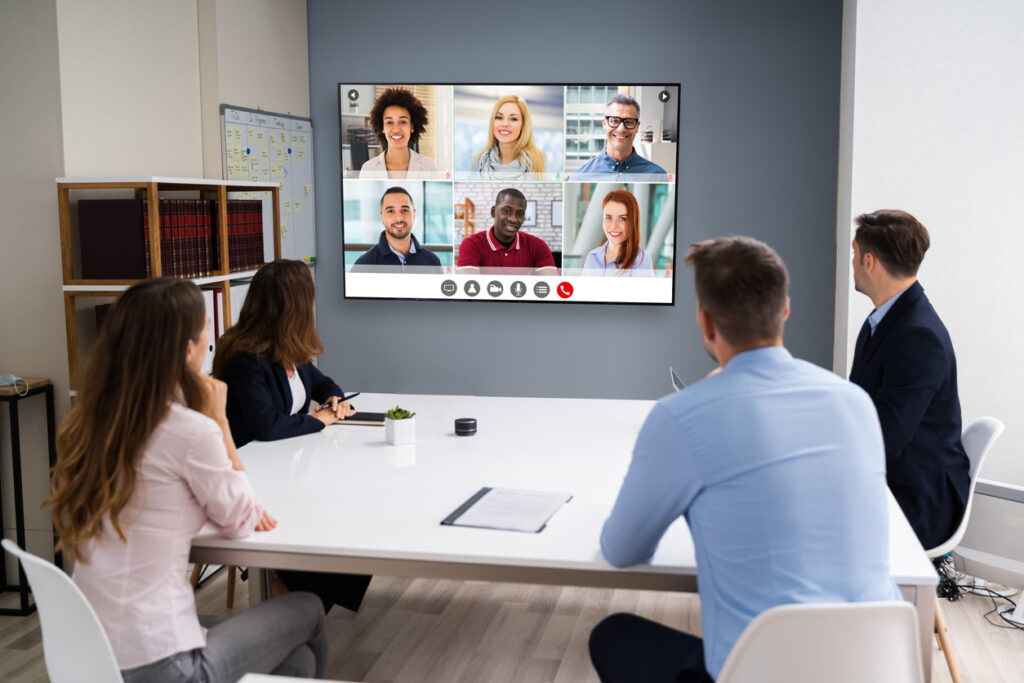Whether you are a small, medium or large organisation, the likelihood is you are having conversations regarding flexible working of some kind, and maybe not realising it.
The last 14 months have empowered and enabled workers across the world to carry out their roles effectively from a flexible environment, whether that’s home, a shared working location or at the usual place of work. The next step in our working revolution is to embrace hybrid working – but what do we mean by this?
We’re starting to see more innovation, creativity and fun than ever before, and what comes with this is a new mindset and skill set.
Unlike hybrid cars, where the benefit of electric is now becoming clear, there doesn’t seem to be a definite definition of this as yet in the working world, but at its core hybrid working is the arrangement or opportunity as an individual worker, team or organisation, to choose part of their working time at home, at the workplace, or another location.
This definition differs again when we start to explore concepts such as hybrid training delivery, where trainers and facilitators are tasked with the challenge of working with learners who are in person, in the same room as them, and some learners in another location joining virtually. This could mean anything from two locations to over 200.
This is both a conceptual and practical challenge for learning and development and is one that needs to be addressed. Now, more than ever before, we need to design our learning with the learner at the centre, as we can easily fall into the trap of isolating subgroups or individuals based on our own preferences, skill, or mindset.
Logistics of hybrid learning
Let’s start about thinking of the logistics and scenarios that we are going to face.
Scenario one: trainer in the room with learners while engaging a virtual audience simultaneously
The research is showing us that initial hybrid training sessions are seeing the trainer chose to be ‘in person’ i.e. physically in the room with other delegates. If you have the majority of delegates in front of you and only one to two individuals dialling in virtually through a device, however, there are various risks to disengagement. For example, if the device isn’t positioned within eye line, or the trainer has a physical style of walking around the room, virtual delegates can easily be forgotten. If you then have virtual delegates who are on one device as opposed to their own devices this isolation, and risk to engagement, can be compounded.
Scenario two: trainer delivering via a remote platform with delegates both in person and remote
If delegates are both together in a room and remote, you may struggle to engage all the in-room delegates, especially if the microphone and camera in the room are not of good quality, or if people are sat out of shot. It may be more natural for you to engage the virtual delegates as you see and hear them more clearly, and you are likely to have an affinity to the virtual platform.
So many combinations – how do I know what to do?
To set yourself up for success, start by getting your head around what the group will look both in terms of location and technology. Then subgroup them. This will open your mind to different combinations of delegate access, help prevent assumptions, and enable you to both design and set up your activities to meet the needs of all.
Option one: the optimal set up
Delegates in person in one room with a good microphone and camera, alongside virtual delegates each with their own device signed in separately. This means everyone can engage, there will be limited audio feedback, and everyone is seen and can be managed effectively.
Option two: a balance
Delegates in person in one room, with a good microphone and camera, alongside virtual delegates in another room, on once device. This means your delegates are in two subgroups in two rooms, which also supports limited audio, and everyone can hopefully be seen. You do have the challenge of managing conversations that might start in the groups and need to manage this. This means you need to design a session that has more of a focus on productive, outcome drive structure to minimise this distraction.
Option three: a virtual focus for all
Delegates in person in one room, on their own devices (or two to a device), alongside virtual delegates in another room on their own device. Everyone is still accessing through a platform that provides a level playing field, but audio could be an issue.
Option four: the least simple
Delegates in person in one room, on their own devices (or two to a device), alongside virtual delegates who are physically in another room with no devices but together on camera. Ideally you want everyone on their own device as this is the trickiest option you may consider.
Ten tips for making it work
As you can see, the group set up alone needs thought and considerations in the design of the programme. Here are ten top tips to start your thinking:
- Educate around the hybrid approach and the impact of getting it right. Share information, examples, joining instructions and videos of the benefit and flexibility it offers.
- Contract upfront with your client or stakeholder where people are going to be and what they need. Don’t be afraid to be directive on this, as people will make assumptions.
- Ensure that any rooms used for in-room subgroups are equipped with decent microphones and cameras so you can see everyone.
- Design your activities to be flexible in the both virtual and in-person setting. Having something you can pull out of your back pocket will serve you well.
- Be clear on how delegates will watch videos and access sound. You won’t have the access to mute speakers as you would in the virtual space so test items such as audio prior to sessions starting.
- Have fun with buddy work and pair up delegates in different locations. Set the challenge of communicating outside of the current set up, support problem solving and digital skills that are added value. Research activities work well here.
- Be really clear in your own mind around people’s roles and how subgroups will access activities and materials. Don’t be afraid to have this written up on slides to save confusion.
- Be creative! You now have access to various environments and an opportunity to make your training look and feel different. Embrace two versions of communications, instructions, materials and exercises.
- Bring virtual best practice in to the in-person world. Visuals, graphics, well design slides and minimal text all still work well to overcome cognitive overload and work well to anchor key learning points.
- Edit your feedback forms to be applicable to the environment or context. This will help you see whether you are favouring one over the other.
We’re starting to see more innovation, creativity and fun than ever before, and what comes with this is a new mindset and skill set. Pilot your hybrid with a co-facilitator to start with and allocate tasks. This will help with any anxiety and overwhelm. Once you see the impact of enabling people to choose how they access learning, your design and delivery will move to the next level, and so will your results.
Interested in this topic? Read Training after Covid-19: will we remain online?
Whether you are a small, medium or large organisation, the likelihood is you are having conversations regarding flexible working of some kind, and maybe not realising it.
The last 14 months have empowered and enabled workers across the world to carry out their roles effectively from a flexible environment, whether that’s home, a shared working location or at the usual place of work. The next step in our working revolution is to embrace hybrid working – but what do we mean by this?
We’re starting to see more innovation, creativity and fun than ever before, and what comes with this is a new mindset and skill set.
Unlike hybrid cars, where the benefit of electric is now becoming clear, there doesn’t seem to be a definite definition of this as yet in the working world, but at its core hybrid working is the arrangement or opportunity as an individual worker, team or organisation, to choose part of their working time at home, at the workplace, or another location.
This definition differs again when we start to explore concepts such as hybrid training delivery, where trainers and facilitators are tasked with the challenge of working with learners who are in person, in the same room as them, and some learners in another location joining virtually. This could mean anything from two locations to over 200.
This is both a conceptual and practical challenge for learning and development and is one that needs to be addressed. Now, more than ever before, we need to design our learning with the learner at the centre, as we can easily fall into the trap of isolating subgroups or individuals based on our own preferences, skill, or mindset.
Logistics of hybrid learning
Let’s start about thinking of the logistics and scenarios that we are going to face.
Scenario one: trainer in the room with learners while engaging a virtual audience simultaneously
The research is showing us that initial hybrid training sessions are seeing the trainer chose to be ‘in person’ i.e. physically in the room with other delegates. If you have the majority of delegates in front of you and only one to two individuals dialling in virtually through a device, however, there are various risks to disengagement. For example, if the device isn’t positioned within eye line, or the trainer has a physical style of walking around the room, virtual delegates can easily be forgotten. If you then have virtual delegates who are on one device as opposed to their own devices this isolation, and risk to engagement, can be compounded.
Scenario two: trainer delivering via a remote platform with delegates both in person and remote
If delegates are both together in a room and remote, you may struggle to engage all the in-room delegates, especially if the microphone and camera in the room are not of good quality, or if people are sat out of shot. It may be more natural for you to engage the virtual delegates as you see and hear them more clearly, and you are likely to have an affinity to the virtual platform.
So many combinations – how do I know what to do?
To set yourself up for success, start by getting your head around what the group will look both in terms of location and technology. Then subgroup them. This will open your mind to different combinations of delegate access, help prevent assumptions, and enable you to both design and set up your activities to meet the needs of all.
Option one: the optimal set up
Delegates in person in one room with a good microphone and camera, alongside virtual delegates each with their own device signed in separately. This means everyone can engage, there will be limited audio feedback, and everyone is seen and can be managed effectively.
Option two: a balance
Delegates in person in one room, with a good microphone and camera, alongside virtual delegates in another room, on once device. This means your delegates are in two subgroups in two rooms, which also supports limited audio, and everyone can hopefully be seen. You do have the challenge of managing conversations that might start in the groups and need to manage this. This means you need to design a session that has more of a focus on productive, outcome drive structure to minimise this distraction.
Option three: a virtual focus for all
Delegates in person in one room, on their own devices (or two to a device), alongside virtual delegates in another room on their own device. Everyone is still accessing through a platform that provides a level playing field, but audio could be an issue.
Option four: the least simple
Delegates in person in one room, on their own devices (or two to a device), alongside virtual delegates who are physically in another room with no devices but together on camera. Ideally you want everyone on their own device as this is the trickiest option you may consider.
Ten tips for making it work
As you can see, the group set up alone needs thought and considerations in the design of the programme. Here are ten top tips to start your thinking:
- Educate around the hybrid approach and the impact of getting it right. Share information, examples, joining instructions and videos of the benefit and flexibility it offers.
- Contract upfront with your client or stakeholder where people are going to be and what they need. Don’t be afraid to be directive on this, as people will make assumptions.
- Ensure that any rooms used for in-room subgroups are equipped with decent microphones and cameras so you can see everyone.
- Design your activities to be flexible in the both virtual and in-person setting. Having something you can pull out of your back pocket will serve you well.
- Be clear on how delegates will watch videos and access sound. You won’t have the access to mute speakers as you would in the virtual space so test items such as audio prior to sessions starting.
- Have fun with buddy work and pair up delegates in different locations. Set the challenge of communicating outside of the current set up, support problem solving and digital skills that are added value. Research activities work well here.
- Be really clear in your own mind around people’s roles and how subgroups will access activities and materials. Don’t be afraid to have this written up on slides to save confusion.
- Be creative! You now have access to various environments and an opportunity to make your training look and feel different. Embrace two versions of communications, instructions, materials and exercises.
- Bring virtual best practice in to the in-person world. Visuals, graphics, well design slides and minimal text all still work well to overcome cognitive overload and work well to anchor key learning points.
- Edit your feedback forms to be applicable to the environment or context. This will help you see whether you are favouring one over the other.
We’re starting to see more innovation, creativity and fun than ever before, and what comes with this is a new mindset and skill set. Pilot your hybrid with a co-facilitator to start with and allocate tasks. This will help with any anxiety and overwhelm. Once you see the impact of enabling people to choose how they access learning, your design and delivery will move to the next level, and so will your results.
Interested in this topic? Read Training after Covid-19: will we remain online?






